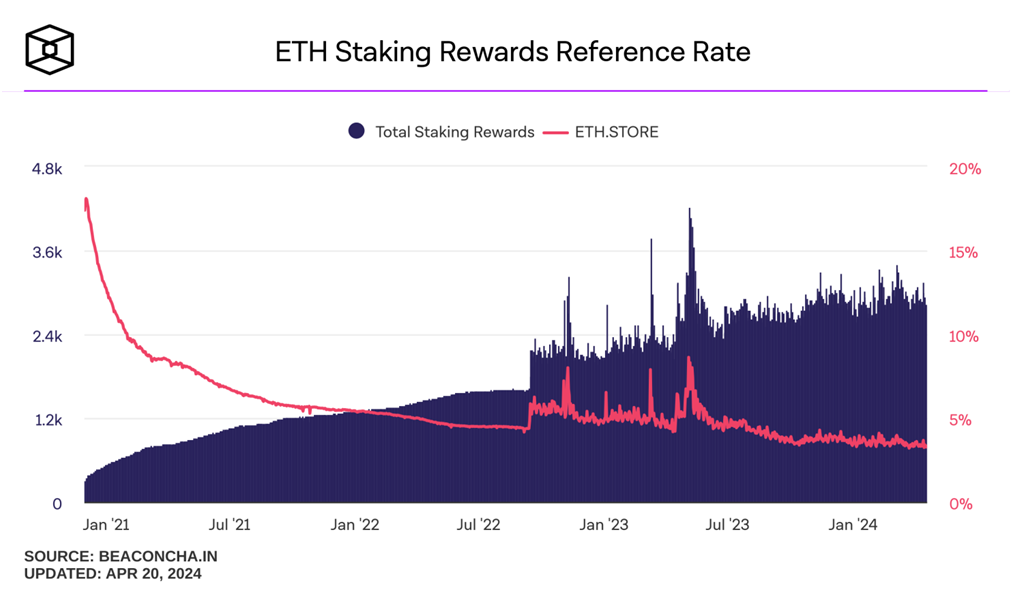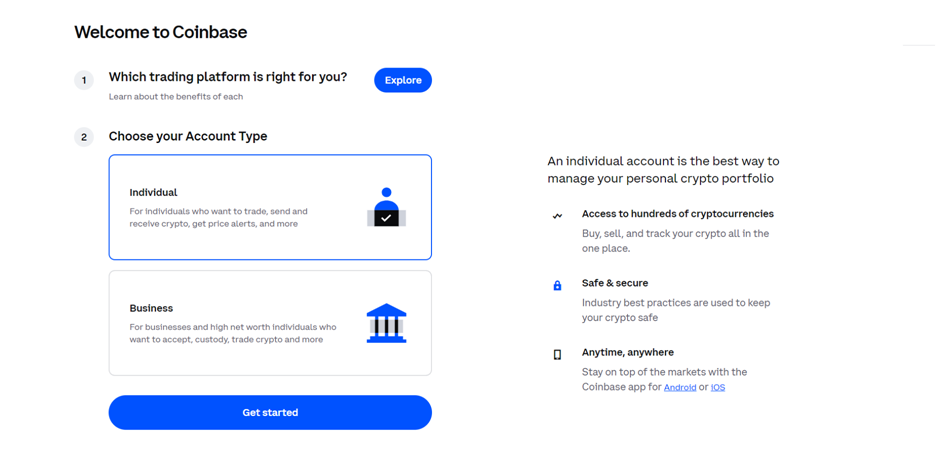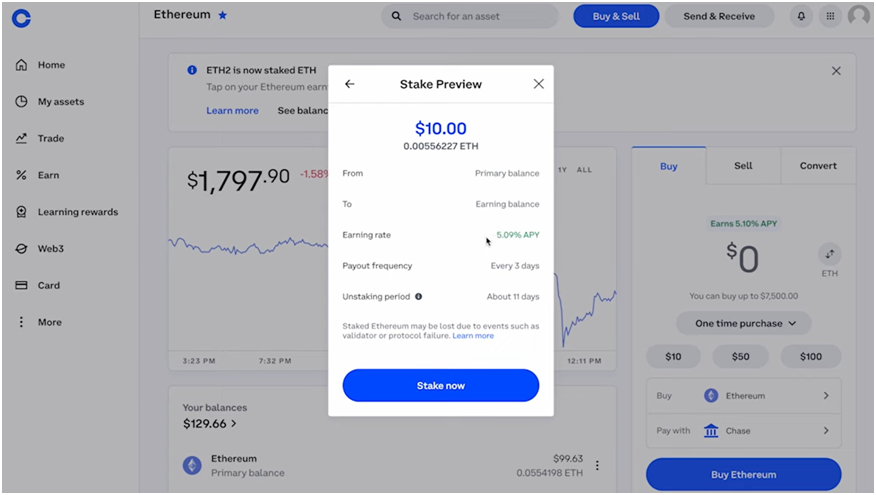
Key takeaways:
- Our investing strategy involves long-term holding of quality crypto assets. (Read more about our investing approach and results.)
- We can earn additional income by using staking products – like investing in interest-bearing accounts. (Read more on How to Stake.)
- One of the most user-friendly staking products is Coinbase Earn, which allows users to stake multiple tokens in just a few clicks. (Here’s how to set it up.)
- Coinbase staking rewards can fluctuate based on the demand for staking on the underlying protocol.
- In this piece, we list the best staking rates for Coinbase Earn, so you can see which tokens have earned the most rewards. (Note: the future may look different.)
Staking on Coinbase Earn
Staking is the flagship service of Coinbase Earn, a product that you users put your crypto to work by staking your digital assets on the platform to earn rewards.
Coinbase Earn offers earning opportunities for multiple cryptocurrencies that are powered by Proof of Stake (PoS) algorithms. That’s why you won’t find bitcoin listed there—it uses a Proof of Work (PoW) consensus mechanism.
As of this writing, Coinbase supports the following assets for staking:
- Ethereum (ETH)
- Cosmos (ATOM)
- Solana (SOL)
- Polkadot (DOT)
- Polygon (POL)
- Tezos (XTZ)
- Cardano (ADA).
To start staking, you can deposit as little as $1 of crypto.
Advantages to Coinbase Earn
There are several reasons why Coinbase Earn is our top pick for crypto staking:
- There are several PoS coins, and staking on each network separately requires significant effort to track all balances and rewards and monitor changes. With Coinbase Earn, you can easily stake all eligible coins from a single dashboard.
- Ethereum has the most staked coin. However, to become a validator, you must deposit at least 32 ETH, roughly $100k as of this writing. Coinbase Earn lowers the entry barrier for Ethereum staking because it pools staking capital and doesn’t impose any threshold on users.
- Coinbase Earn is user-friendly and is excellent for beginners who may not understand all the intricacies of staking.
- Coinbase takes measures to reduce all risks related to validator failure, called slashing, which can lead to loss of staked funds. Coinbase has never experienced a slashing loss.
In other words, Coinbase Earn does all the behind-the-scenes work for staking crypto assets while users simply reap the benefits.
In return for this convenience, Coinbase takes a 35% commission. You can reduce this fee to around 26% for certain tokens by joining Coinbase One. (More info on fees here.)
Beyond Coinbase’s commission, the blockchain network dictates the staking rate. This is why the staking rates vary greatly from coin to coin. More on this below.
Best Staking Rates Today
Note that higher reward rates don’t necessarily suggest better investments.
For example, Polkadot (DOT) currently pays over 9% in staking rewards, but it has the highest inflation rate among major tokens.
Elsewhere, Solana (SOL) currently pays less than 5%, but it has been the best-performing Layer-1 coin since 2023, and the price increase has been reflected in the return.
Our approach is to invest long-term in valuable tokens, and see staking rewards as additional growth on your investment. Invest in the token, not in the staking rate.
Staking Rates Fluctuate
Crypto investors should also consider the fluctuating nature of staking rewards.
For example, one year ago, Coinbase Earn offered an annual percentage yield (APY) of 3.83% for Ethereum (ETH) and 2.5% for Solana (SOL).
These fluctuations depend on the underlying chains. As a rule, two main factors drive staking yields: the amount of staked coins, and the participation rate. When more crypto holders stake, the reward rate tends to decrease, as everyone is sharing the same pie.
The Role of Restaking for ETH Holders
Ethereum is an isolated case because it has an entire staking industry built around it.
EigenLayer introduced a staking innovation called restaking, which enables ETH holders to amplify staking rewards by repurposing the staked ETH to secure decentralized applications (dapps). (See our guide to EigenLayer here.)
It’s worth noting that while the growing popularity of restaking and liquid staking protocols enhances the appeal of ETH staking, it dilutes the overall rewards, including the yields offered by Coinbase Earn. (Again, more participants, but same-size pie.)

Which Platform Offers Best Staking Rates?
Coinbase may charge some of the highest fees among custodial staking platforms, but many crypto investors choose it for its simplicity, security, trust, and reputation.
Here is how Coinbase Earn compares to other staking platforms. (Remember that Coinbase commission can be reduced to 26.3% for eligible Coinbase One members.)
How to Get Started with Coinbase Earn
Getting started with staking at Coinbase is easy. Here are the main steps:
- Set up your Coinbase Account: During registering, you can choose the account type you want – individual or business – and then share your data, including your name and email address. Make sure to set a strong password.

- Verify your email and phone number and provide additional personal information.
- After finishing registration, you should go through the KYC verification process, which requires you to upload ID documents and then link a payment method to make deposits.
- Enable 2FA – We strongly recommend enabling two-factor authentication (2FA), which will help secure your account further, in case your password is compromised.
- Start staking with Coinbase Earn – after registering and depositing funds, go to the Earn page and pick one of the eligible crypto coins or click “Earn” on your account. Just follow the simple instructions to stake crypto and earn rewards.

Note that the frequency of reward payouts varies by protocol and that crypto funds need to be unstaked before they can be traded. Depending on the protocol, unstaking can take a few hours to a few weeks.
The best way to minimize staking risks is to build a staking portfolio and allocate to multiple coins.
Investor Takeaway
Coinbase Earn offers an accessible way to stake crypto assets, with low barriers to entry and a user-friendly interface, making it ideal for beginners.
With this guide, you can see which crypto investments are paying the most rewards. But remember, invest in quality crypto assets first, and enjoy the staking rewards as gravy.
Subscribe to our Bitcoin Market Journal newsletter to get more crypto investing tips delivered to your inbox.

